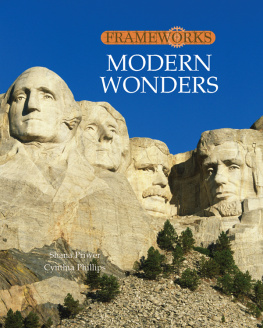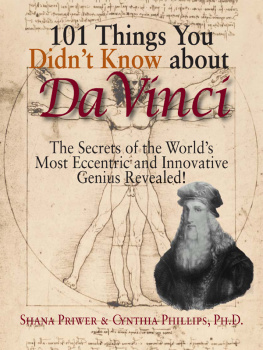FRAMEWORKS
MODERN

WONDERS
Shana Priwer
Cynthia Phillips
First published 2009 by M.E. Sharpe
Published 2015 by Routledge
2 Park Square, Milton Park, Abingdon, Oxon OX14 4RNM
711 Third Avenue, New York, NY 10017
Routledge is an imprint of the Taylor & Francis Group, an informa business
Copyright Taylor & Francis. All rights reserved.
No part of this book may be reprinted or reproduced or utilised in any form or by any electronic, mechanical, or other means, nowknown or hereafter invented, including photocopying and recording, or in anyinformation storage or retrieval system, without permission in writing from the publishers.
Notices
No responsibility is assumed by the publisher for any injury and/or damage to persons or property as a matter of products liability, negligence or otherwise, or from any use of operation of any methods, products, instructions or ideas contained in the material herein.
Practitioners and researchers must always rely on their own experience and knowledge in evaluating and using any information, methods, compounds, or experiments described herein. In using such information or methods they should be mindful of their own safety and the safety of others, including parties for whom they have a professional responsibility.
Product or corporate names may be trademarks or registered trademarks, and are used only for identification and explanation without intent to infringe.
Library of Congress Cataloging-in-Publication Data
Modern wonders / Cynthia Phillips and Shana Priwer.
p. cm. -- (Frameworks)
Includes bibliographical references and index.
ISBN 978-0-7656-8124-9 (hardcover : alk. paper)
1. Architecture, Modern--Juvenile literature. 2. Architecture and
technology--Juvenile literature. I. Priwer, Shana. II. Title.
NA680.P3786 2008
724.6--dc22
2007040700
Editor: Peter Mavrikis
Production Manager: Henrietta Toth
Editorial Assistant and Photo Research: Alison Morretta
Program Coordinator: Cathy Prisco
Design: Patrice Sheridan
Line Art: FoxBytes
PHOTO CREDITS: Cover: Dorling Kindersley/Getty Images; title page: Taxi/Getty Images; : De Agostini Picture Library/Getty Images; back cover: Photographers Choice/Getty Images.
ISBN 13: 9780765681249 (hbk)
CONTENTS
Architecture has undergone sweeping development since the beginning of time. In biblical days, most architecture was temporary because it accommodated a nomadic population. As communities began to grow roots, so did their architecture. Whether it was residential, commercial, religious, or civic, structures of permanence slowly appeared on the global landscape.
Over time, specific aesthetics and structural techniques were developed. The knowledge of physical sciences became more advanced and, as a result, engineers responded by creating increasingly complex works that challenged previous notions. Temples became more elaborate, buildings grew ever taller, and bridges spanned bodies of water that only boats had dared to cross before. Once science and design crossed paths, there was no turning back.
The goal of the FRAMEWORKS series is to provide insight into the science behind the structures that are part of our everyday lives. Dams require advanced hydroelectric technology; the Egyptian pyramids paved new paths in the transport of stone and the construction of stone structures. Basic concepts from mathematics, physics, and engineering help illustrate the science that supports the creation of increasingly complex structures.
This series assumes no prior knowledge of advanced math and physics, but rather builds up the readers understanding by explaining scientific concepts in words as well as equations. Engaging examples are used to illustrate ideas such as mass, force, speed, and energy. Case studies from real-world projects demonstrate the concepts. Famous disasters also serve an important purpose in showing how even for professional architects and engineers, gaining knowledge is a slow and gradual task.
MODERN WONDERS describes several of the crowning architectural achievements of recent centuries. Steel was a major factor in the creation of the Eiffel Tower. Without steel and other essential engineering advances, this tower and subsequent skyscrapers would never have been possible. Another amazing structure, the St. Louis Gateway Arch, took building with steel to new levels.
Curvilinear buildings, where curved rather than straight lines define part or all of the structure, have become increasingly popular in recent years, in large part due to advances in computer software that allow for their design and fabrication. The Sydney Opera House is an example of a project that took advantage of engineering and construction technology and managed to respect the intended use of the space at the same time. The Bilbao Guggenheim Museum, on the other hand, was made possible by computer-aided design and manufacturing software that was not available at the time that the Sydney Opera House was built. It was not possible to produce building elements that curved simultaneously in multiple directions on a large scale prior to recent developments in computer design technology.
Unfortunately, some masterful architectural achievements have fallen to terrorism or other disasters. The Twin Towers of the World Trade Center in New York City pushed the field of skyscraper design to new heights, both literally and figuratively. They were the subjects of two other disasters before their ultimate demise in the terrorist attacks of September 11, 2001, and the site where they stood is currently the focus of a major rebuilding effort.
Some engineering wonders are not intended for habitation. Mount Rushmore is a massive sculpture carved into the South Dakota Black Hills. It commemorates the achievements of the nation in a way that also celebrates the natural landscape. Similarly, large amusement park rides such as the Millennium Eye in London simultaneously celebrate engineering achievement, materials innovation, and creative ingenuity. The range of impressive designs in recent centuries is a testament to the expertise of the people involved in every aspect of these building projectsfrom the development of materials down to the last detail of construction.
The FRAMEWORKS series provides an entertaining and educational approach to the science of building. Read on to learn about the ways in which science supports, literally, our built environment.

Engineer Gustave Eiffel stands below the Eiffel Tower during its construction in 1888.
CHAPTER
The driving force behind new architectural works can come from a number of sources. Famous and wealthy individuals sometimes sponsor monuments to commemorate their lives, cities sponsor new development in the interest of encouraging the local economy, and architectural masterpieces can even be created purely for showmanship and competition.
The Eiffel Tower fits into the last category. This building was designed and created exclusively for the Paris Exposition of 1889, and had it not been for the buildings proven usefulness, it likely would have been torn down after the main event. The exposition was held on the centennial of the French Revolution and included exhibits and temporary structures to celebrate French achievements.
















